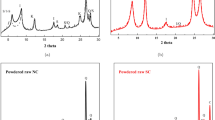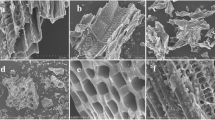Abstract
A selected commercially available sulphonated oil (SO) and a polymer were evaluated for use as soil stabilizers in a laboratory-based investigation. Two naturally occurring soils (Mercia mudstone [MM] and Oxford clay [OC]) and limestone quarry fines (LQF) were treated with the SO, a polymer, and a combination of the SO and the polymer for assessment of changes in their engineering properties. Untreated specimens also were tested to serve as a control condition. Stabilizer performance was evaluated based on the provisions of ASTM D4609-08 (2008). The test results indicated that performance was dependent on both the soil type and the stabilizer dosage. Generally, treatment did not lead to substantial changes in index properties or maximum dry density. However, the optimum moisture content for LQF was substantially reduced (17–35 %) together with improvements in both dry strength (unconfined compressive strength [UCS]: 38 % for MM, 26 % for OC, >500 % for LQF; static flexural strength [SFS]: 60 % for MM and OC, >500 % for LQF) and swell characteristics (20 % for OC, 21–61 % for MM). Applied in the proper context, the stabilizers are suitable for the treatment of soils for low-volume roads.











Similar content being viewed by others
References
AASHTOT180-10 (2010) Standard method of test for moisture-density relations of soils using a 4.54-kg (10-lb) rammer and a 457-mm (18-in.) drop. American Association of State Highway and Transportation Officials, Washington, DC
Abadjieva T (2001) Chemical for low-cost roads in Botswana. In: Proceedings of First Road Transportation Technology Transfer Conference in Africa, Arusha, Tanzania, 23–25 May 2001. Tanzania Ministry of Works, Dar es Salaam
Ajayi-Majebi A, Grissom WA, Smith LS, Jones EE (1991) Epoxy-resin based chemical stabilization of a fine, poorly graded soil system. Transportation research record 1295. Transportation Research Board, Washington, DC, pp 95–108
Al-Khanbashi A, Abdalla SW (2006) Evaluation of three waterborne polymers as stabilizers for sandy soil. Geotech Geol Eng 24(6):1603–1625
American Concrete Institute (ACI)—Committee 230 (1990) State-of-the-art report on soil-cement. Mater J 87(4):395–415
ASTM D1632-07 (2007) Standard practice for making and curing soil-cement compression and flexure test specimens in the laboratory. ASTM International, West Conshohocken
ASTM D1635-06 (2006) Standard test method for flexural strength of soil-cement using simple beam with third-oint loading. ASTM International, West Conshohocken
ASTM D4609-08 (2008) Standard method for evaluation of chemical stabilisation additives. ASTM International, West Conshohocken
Bolander P (1999) Laboratory testing of nontraditional additives for stabilizing roads and trail surfaces. Transportation research record 1652. Transportation Research Board, Washington, DC, pp 24–31
BSI (1990a) BS 1377: methods of test for soils for engineering purposes. The British Standard Institution, London
BSI (1990b) BS 1924: stabilized materials for civil engineering purposes. The British Standards Institution, London
BSI (1999) BS 5930: code of practice for site investigations. The British Standards Institution, London
Cokca E (2002) Relationship between methylene blue value, initial soil suction,and swell percent of expansive soils. Turk J Eng Environ Sci 26:521–529
Cokca E, Birand A (1993) Determination of cation exchange capacity of clayey soils by methylene blue test. Geotech Test J 16(4):518–524
Coleman JE (1997) Chemical stabilization of expansive soils. In: Proceedings of Texas section of ASCE fall 1997 conference. Texas—ASCE, Austin, pp 158–165
Cook JR, Petts RC, Rolt J (2013) The international low volume road pavement and surfacing guideline. In: Proceedings of 6th Africa Transportation Technology Transfer Conference, 4–8 March, Gaborone, Botswana, pp 102–113
Fohs DG (1975) Laboratory evaluation of two proprietary materials as compaction aids and soil stabilisers. FHWA-RD-75-32. Federal Highway Administration, Washington, DC
Geiman CM (2005) Stabilisation of soft clay subgrades in Virginia phase I laboratory study. Master’s thesis. Virginia Polytechnic Institute and State University, Blacksburg
Geiman CM, Filz GM, Brandon TL (2005) Stabilisation of soft clay subgrades in Virginia: phase I laboratory study (VTRC 05-CR16). Virginia Transportation Research Council, Charlottesville
Ghataora GS (2000) Appropriate and efficient maintenance for low-cost rural roads. Report 5: review of stabilisation methods. DFID Report R6852. DFID (Roughton International/University of Birmingham/The University of Nottingham), London
Greening PAK, Paige-Green P (2003) Evaluation of sulphonated petroleum products as soil stabilisers and compaction aids. Transport Research Laboratory, Berkshire
Han ZT, Wang Z, Dong Y, Hu Y, Yao Z (2007) Chemical stabilization of mobile dune fields along a highway in the Taklimakan desert of China. J Arid Environ 68(2):260–270
Harris P, Von Holdt J, Sebesta S, Scullion T (2006) Recommendations for stabilization of high-sulfate soils in Texas. Report no. FHWA/TX-06/0-4240-3. Texas Transportation Institute, The Texas A&M University System, College Station, Texas
Hoover JM, Handy RL (1978) Chemical compaction aids for fine-grained soils. Final report, vols 1 and 2. FHWA-RD-79-63 and FHWA-RD-79-64. Federal Highway Administration, Washington, DC
Imperial Chemical Industries (ICI) (1986) Lime stabilisation manual. ICI, Derbyshire
Ingles OG, Metcalf JB (1972) Soil stabilisation. Butterworths, Sydney
Iyengar SR, Masad E, Rodriguez AK, Bazzi HS, Little D, Hanley HJM (2013) Pavement subgrade stabilization using polymers: characterization and performance. J Mater Civ Eng 25(4):472–483
Kassian WNJ (2001) Typical field application of consolid in Tanzania. In: Proceedings of First Road Transportation Technology Transfer Conference in Africa, Arusha, Tanzania, 23–25 May 2001. Tanzania Ministry of Works, Dar es Salaam
Katz LE, Rauch AF, Liljestrand HM, Harmon JS, Shaw KS, Albers H (2001) Mechanisms of soil stabilisation with liquid ionic stabiliser. Transportation Research Record 1757. Transportation Research Board, Washington, DC, pp 50–57
Kezdi A (1979) Stabilized earth roads. Elsevier, Amsterdam
Kimball CE (1997) Evaluating groundwater pollution susceptibility of dust suppressants and roadbed stabilizers: case study of a petroleum-based product. In: Transportation Research Record 158. Transportation Research Board/National Research Council, Washington DC, pp 64–69
Lahalih SM (1998) Development and evaluation of new multipurpose soil additives. Indust Eng Chem Res 37(2):420–426
Lahalih SM, Ahmed N (1998) Effect of new soil stabilizers on the compressive strength of dune sand. Constr Build Mater 12:321–328
Little DN, Males EH, Prusinski JR, Stewart B (2000) Cementitious Stabilization. Millenium Paper Series. Transportation Research Board, Washington, DC
Liu J, Shi B, Gu K, Jiang H, Inyang HI (2012) Effect of polyurethane on the stability of sand–clay mixtures. Bull Eng Geol Environ 71(3):537–544
Meyers JF, Pichumani R, Kapples BS (1976) Fly ash as a construction material for highways: a manual. Report FHWA-IP-76-16. Federal Highway Administration, US Department of Transportation, Washington, DC
Naeini SA, Naderinia B, Izadi E (2012) Unconfined compressive strength of clayey soils stabilized with waterborne polymer. KSCE J Civil Eng 16(6):943–949
National Lime Association (NLA) (1985) Lime stabilisation construction manual. National Lime Association, Arlington
Newman K, Tingle JS (2004) Emulsion polymers for soil stabilization. FAA Worldwide Airport Technology Transfer Conference, Atlantic City, New Jersey, April 2004
Newman JK, Tingle JS, Gill R, McCaffrey T (2005) Stabilization of silty sands using polymer emulsion. Int J Pavements 4:1–12
Oketola OI (2004) Behaviour of stabilised soils subjected to cyclic loading. MSc thesis. Department of Civil Engineering, University of Birmingham, UK
Oldham JC, Eaves RC, White DW (1977) Materials evaluated as potential soil stabilisers. Miscellaneous paper S-77-15. US Army Corps of Engineer, Waterways Experiment Station, Vicksburg
Onyejekwe S (2006) Soil stabilisation with a polymer, sulphonated petroleum product and cement, and reinforcement with fibres. MPhil thesis. Department of Civil Engineering, University of Birmingham, UK
Paige-Green P, Coester K (1996) Towards successful SPP treatment of local materials for road building. CSIR. Report no. RR93/286. Department of Transport, Pretoria, South Africa
Park J, Vipulanandan C, Kim JW, Oh MH (2006) Effects of surfactants and electrolyte solutions on the properties of soil. Environ Geol 49(7):977–989
Petry TM (1997) Performance-based testing of chemical stabilisers. In: Transportation Research Record 1589. Transportation Research Board/National Research Council, Washington DC, pp 42–49
Petry TM, Armstrong JC (1989) Stabilisation of expansive soils. In: Transportation Research Record 1219. Transportation Research Board/National Research Council, Washington DC, pp 103–112
Petry TM, Das B (2001) Evaluation of chemical modifiers and stabilisers for chemically active soils–clays. In: Transportation Research Record 1757. Transportation Research Board/National Research Council, Washington DC, pp 43–49
Petry TM, Little DN (2002) Review of stabilisation of clays and expansive soils in pavements and lightly loaded structures: history, practice, and future. J Mater Civil Eng 14(6):47–460
Rauch AF, Harmon JS, Katz LE, Liljestrand, JE (2002) Measured effects of liquid soil stabilisers on the engineering properties of clay. In: Transportation Research Record 1787. Transportation Research Board/National Research Council, Washington, DC, pp 33–41
Rauch AF, Katz LE, Liljestrand HM (2003) An analysis of the mechanisms and efficacy of three liquid chemical soil stabilizers. Center for Transportation Research, The University of Texas at Austin
Road Research Laboratory/Department of Scientific and Industrial Research (RRL/DSIR) (1959) Soil mechanics for road engineers. HMSO, London
Santoni RL, Tingle JS, Webster SL (2002) Stabilisation of silty sand with nontraditional additives. In: Transportation Research Record 1787. Transportation Research Board/National Research Council, Washington DC, pp 61–70
Santoni RL, Tingle JS, Nieves M (2003) Accelerated strength improvement of silty sand using nontraditional additives. In: 2003 TRB Annual Meeting CD-ROM
Scholen DE (1992) Nonstandard stabilisers. Report no. FHWA-FLP-92-011. Federal Highway Administration, Washington, DC
Scholen DE (1995) Stabiliser mechanisms in nonstandard stabilisers. In: Conference Proceedings 6: Low-Volume roads, vol 2. Transportation Research Board/National Research Council, Washington DC, pp 252–260
Sherwood PT (1993) Soil stabilisation with cement and lime. HMSO, London
Siddiqi RA, Moore JC (1981) Polymer stabilisation of sandy soils for erosion control. In: Transportation Research Record 827. Transportation Research Board/National Research Council, Washington, DC, pp 30–34
So WS (2002) Engineering properties of stabilised soils. MSc thesis. Department of Civil Engineering, University of Birmingham, UK
Steevens J, Suedel B, Gibson A, Kennedy A, Blackburn W, Splichal D, Pierce JT (2007) Environmental evaluation of dust stabilizer products. Report no. ERDC/EL TR-07-13. Engineer Research and Development Center, Vicksburg
Thomas JA (2002) Chemical soil stabilization: a laboratory comparison of the effectiveness of three liquid products and lime. MS thesis. University of Texas at Austin, Austin
Tingle JS, Santoni RL (2003) Stabilisation of clay soils with nontraditional additives. In: Transportation Research Record 1819. Transportation Research Board/National Research Council, Washington, DC, pp 72–84
Yasrobi SS, Zandieh AR, Mortezaiy M (2007) Effect of nontraditional additives on the compressive strength of dune sand. In: Proceedings of First Sri Lankan Geotechnical Society (SLGS) International Conference on Soil and Rock Engineering, 5–11 August 2007, Colombo, Sri Lanka
Zandieh AR, Yasrobi SS (2010) Study of factors affecting the compressive strength of sandy soil stabilized with polymer. Geotech Geol Eng 28:139–145
Ziaie-Moayed R, Samimifar M, Kamalzare M (2011) Improvement of shear strength characteristics of saline soil using cement and polymer. Int J Geotech Eng 5(3):307–314
Acknowledgments
For this study, Salversen Brickworks, Walsall, and West Midlands provided the MM samples; Hanson Brickworks, Stewartby, and Bedfordshire supplied the OC samples; Tarmac Ltd provided the limestone quarry fines; and M/S Sovereign CS Ltd, Middlesex, and UK supplied the stabilizers. The authors are grateful for the support provided. The authors thank the staff of the Centre for Electron Microscopy, University of Birmingham, UK for help with the SEM and with interpretation of the SEM images.
Author information
Authors and Affiliations
Corresponding author
Rights and permissions
About this article
Cite this article
Onyejekwe, S., Ghataora, G.S. Soil stabilization using proprietary liquid chemical stabilizers: sulphonated oil and a polymer. Bull Eng Geol Environ 74, 651–665 (2015). https://doi.org/10.1007/s10064-014-0667-8
Received:
Accepted:
Published:
Issue Date:
DOI: https://doi.org/10.1007/s10064-014-0667-8




